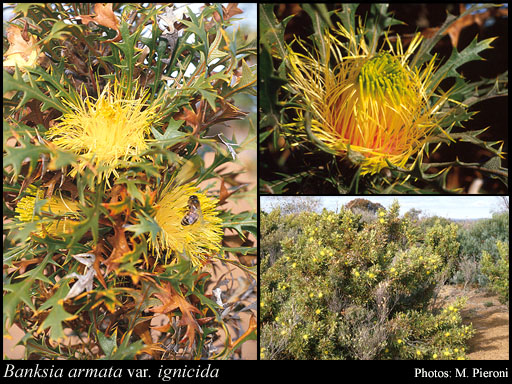- Reference
- Austral.Syst.Bot. 20:66 (2007)
- Conservation Code
- Not threatened
- Naturalised Status
- Native to Western Australia
- Name Status
- Current
Erect, prickly, non-lignotuberous shrub, 1-2.5(-3) m high. Fl. yellow, Jun to Oct. Gravelly sand, clay or loam over laterite, sand over granite or limestone.

Scientific Description
Shrubs, 1.5-3 m high; branchlets glabrous or hairy. Leaves petiolate, alternate, 40-105 mm long, 15-25 mm wide, hairy; petiole 6-12 mm long; lamina flat, once divided, pinnately divided, deeply divided, with 8-12 lobes on each side, the margins flat. Inflorescences hirsute (with long, rough and coarse hairs), yellow; innermost bracts 15-25 mm long, hairy. Perianth 25-35 mm long, glabrous, without awns; pistil 35-45 mm long, straight or curved, style glabrous. Follicles hairy, pubescent (with soft, straight, erect hairs), obovate, 9-12 mm long. Flowers in September. Occurs in the South-west (SW) Botanical Province(s), in the Avon Wheatbelt (AW), Jarrah Forest (JF), Mallee (MAL) or Esperance Plains (ESP) IBRA subregion(s).
Distribution
- IBRA Regions
- Avon Wheatbelt, Esperance Plains, Geraldton Sandplains, Jarrah Forest, Mallee.
- IBRA Subregions
- Eastern Mallee, Fitzgerald, Katanning, Lesueur Sandplain, Northern Jarrah Forest, Recherche, Southern Jarrah Forest.
- IMCRA Regions
- WA South Coast.
- Local Government Areas (LGAs)
- Albany, Beverley, Busselton, Dandaragan, Dumbleyung, Esperance, Jerramungup, Katanning, Pingelly, Plantagenet, Quairading, Ravensthorpe, Toodyay, Wagin, Wandering, Woodanilling, York.